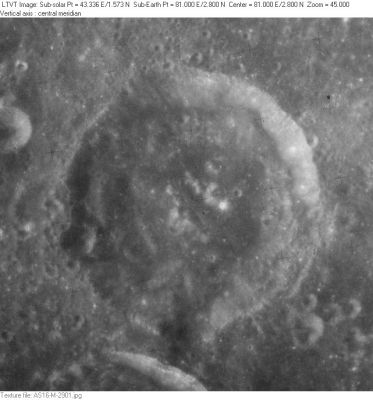Schubert
Contents
Schubert
|
Lat: 2.8°N, Long: 81.0°E, Diam: 54 km, Depth: 3.35 km, Rükl: 38 |

Images
LPOD Photo Gallery Lunar Orbiter Images Apollo Images
Exploring the north-northwestern part of Mare Smythii near crater Schubert
- Orbital Hasselblad photograph AS11-44-6562, made during the mission of Apollo 11 in july 1969, shows Schubert C (the LTO's Doyle) a little bit below and slightly to the right of the frame's centre. Schubert C (Doyle) is the large crater with the cluster of bright (and rather flat) central peaks. The bright bowl-shaped crater at right (near the frame's right margin) is Peek, and the partially incomplete ring "below" Peek (to the east of Peek) is the LTO's Pirandello. Immediately to the "left" (to the south) of Schubert C (Doyle) is the LTO's Camoens, which doesn't seem to have received one of the IAU's official letter designations. The crater Schubert itself (with its companion Back, south ("left") of Schubert) is noticeable at the curved horizon.
- AS11-44-6642 shows the same region, with the approaching Ascent Stage of LM Eagle in front of it. Schubert C (Doyle) is noticeable just below Earth.
- Lunar Orbiter 1 photograph Frame 005 med shows Schubert C (the LTO's Doyle) a little bit to the right of the frame's centre, and the LTO's Camoens south-southeast of it. Schubert itself (the eastern part of its rim and a little bit of its shadowed interior) is noticeable at the left margin.
- Lunar Orbiter 1 photograph Frame 026 med shows the dark mare-like region Schubert N with its "own" Concentric Crater (near its southeastern rim). This Concentric Crater is item N°12 in C.A.Wood's list published in 1978.
Research Lunar Orbiter and Apollo photographs: Danny Caes
Maps
(LAC zone 63C4) USGS Digital Atlas PDF LTO map
Description
Description: Elger
(IAU Directions) SCHUBERT.--This ring-plain, about 46 miles in diameter, situated on the N.W. side of the Mare Smythii, is too near the limb to be well observed.
Description: Wikipedia
Additional Information
- Depth data from Kurt Fisher database
Pike, 1976: 3.35 km
Westfall, 2000: 3.35 km - Concentric Crater (CC) near (or rather: touching) the southeastern part of the dark lake-like region Schubert N.
Nomenclature
- Theodor Friedrich von; Russian cartographer (1789-1865).
- According to Whitaker (p. 219), this name was introduced by Mädler.
- Crater Schubert B was called Fébrer by Hugh Percy Wilkins and Patrick Moore, but the I.A.U. did not accept that name.
- Fébrer (Joaquin Fébrer Carbo) was a contemporary Spanish astronomer.
- Schubert C is called Doyle on LTO 63-C4, the crater south of Schubert C is called Camoens. Who was Doyle? See this Wikipedia-page.Who was Camoens? See this Wikipedia-page.
- Schubert C (the LTO's Doyle) was frequently photographed during the mission of Apollo 11, especially during the pre-docking activities of CSM Columbia and the Ascent Stage of LM Eagle (the well-known photographs which show the approaching Ascent Stage, the moon's curved horizon, and Earth in the distance).
- Schubert N, a dark lake-like region at 1.8° North/ 72.7° East, was frequently photographed during the orbital mission of Apollo 10. See also the lower left corner of LAC 63 (page 126) in the Clementine Atlas of the Moon. Research: Danny Caes
LPOD Articles
Bibliography
A Portfolio of Lunar Drawings (Harold Hill), page 35 (Mare Smythii).
Schubert B ("Fébrer"): THE MOON by H.P.Wilkins and P.Moore.